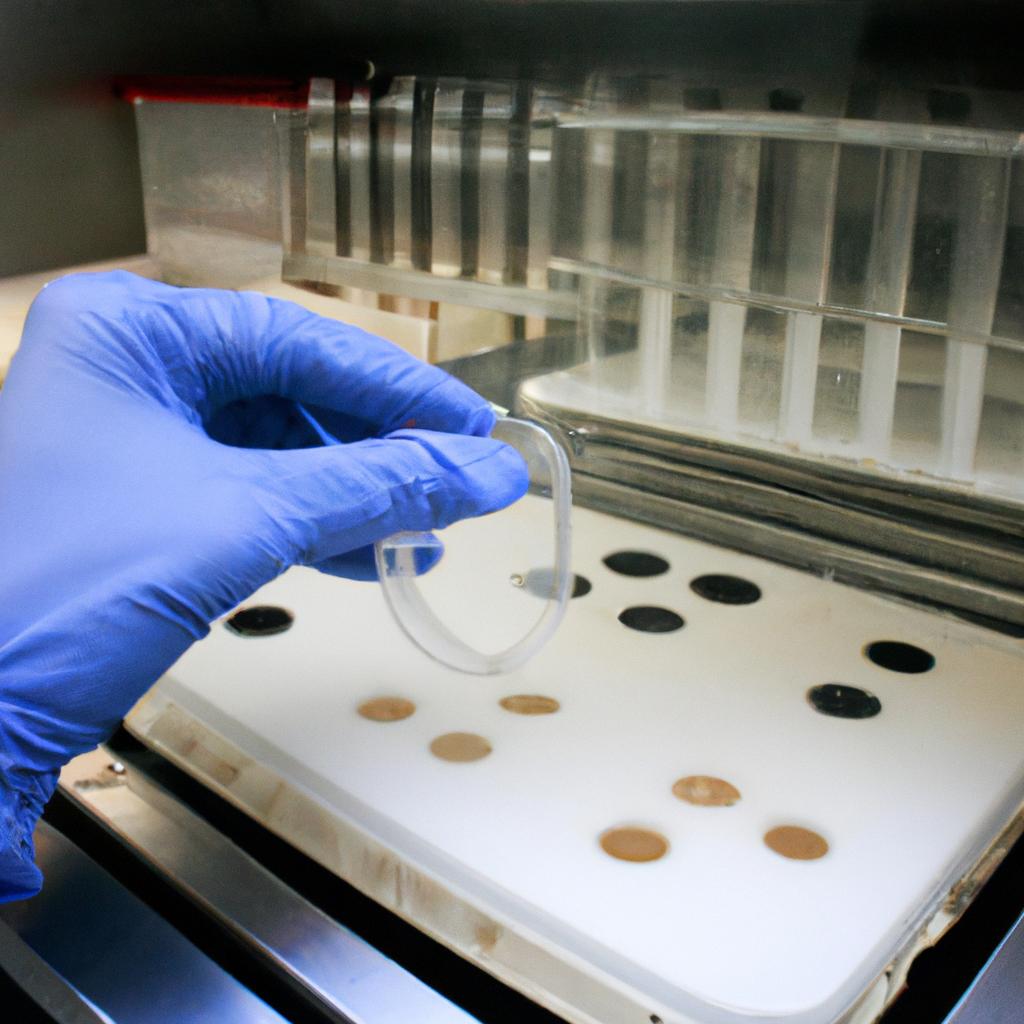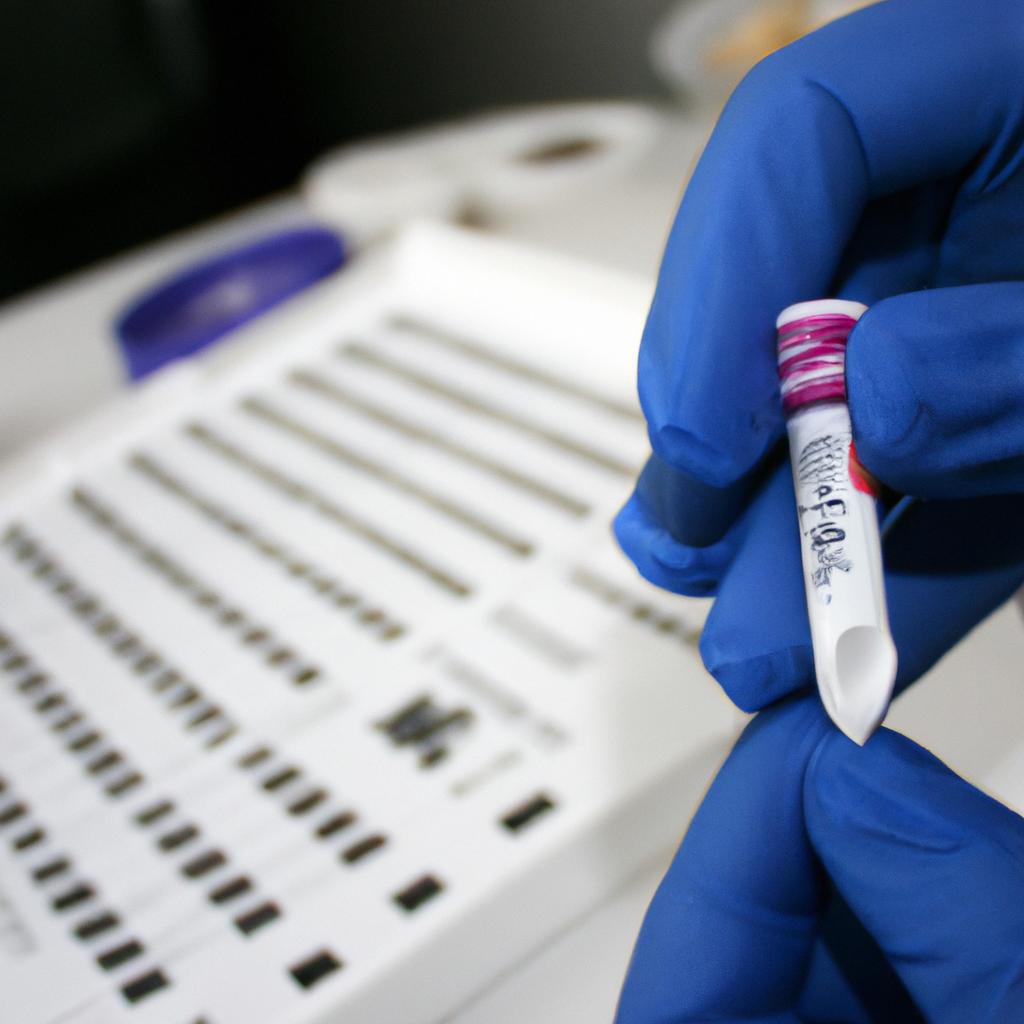Blood gas analysis is a crucial tool in veterinary clinical pathology, providing valuable insights into the acid-base balance and respiratory status of animals. This diagnostic technique allows for the evaluation of blood pH, partial pressure of oxygen (pO2), partial pressure of carbon dioxide (pCO2), bicarbonate ion concentration (HCO3-), and other key parameters that play a significant role in maintaining homeostasis. For instance, consider the case study of a dog presenting with rapid breathing and lethargy. By performing a blood gas analysis, veterinarians can assess whether there is an underlying respiratory or metabolic disorder contributing to these symptoms.
In recent years, advances in technology have revolutionized blood gas analysis in veterinary medicine, enabling more accurate and efficient results. Traditionally, this procedure involved collecting arterial blood samples via invasive techniques such as arterial puncture or cannulation; however, newer non-invasive methods are now available. These include transcutaneous monitoring systems that measure gases through the skin surface without penetrating vessels directly. Additionally, point-of-care analyzers have become increasingly popular due to their portability and ability to deliver near-real-time results at the patient’s bedside. With these advancements, veterinarians can promptly diagnose and manage critical conditions by closely monitoring changes in acid and oxygenation status.
Blood gas analysis provides crucial information regarding the acid-base balance of an animal. The pH value indicates whether the blood is more acidic or alkaline, with a normal range typically between 7.35-7.45 in animals. Deviations from this range can indicate respiratory or metabolic disorders. Respiratory acidosis occurs when there is an accumulation of carbon dioxide in the body due to inadequate ventilation, leading to decreased pH levels. On the other hand, respiratory alkalosis results from excessive elimination of carbon dioxide through hyperventilation, causing an increase in pH levels.
In addition to evaluating acid-base balance, blood gas analysis also measures partial pressure of oxygen (pO2) and partial pressure of carbon dioxide (pCO2). Oxygen plays a critical role in cellular respiration and overall tissue function. Low pO2 values may suggest impaired oxygen delivery or utilization, which could be due to respiratory disorders, cardiovascular problems, or anemia. High pCO2 values indicate hypoventilation or impaired removal of carbon dioxide from the body, often seen in conditions such as respiratory depression or airway obstruction.
Bicarbonate ion concentration (HCO3-) is another parameter assessed during blood gas analysis. Bicarbonate acts as a buffer system that helps regulate pH by absorbing excess hydrogen ions when blood becomes too acidic and releasing them when blood becomes too alkaline. Changes in bicarbonate levels can provide insights into underlying metabolic disturbances such as renal dysfunction or metabolic acidosis/alkalosis.
By analyzing these parameters together, veterinarians can better understand the overall respiratory and metabolic status of an animal and make informed decisions regarding treatment options. Blood gas analysis is especially useful in emergency situations where prompt intervention may be required to stabilize the patient’s condition.
It’s important to note that while blood gas analysis is a valuable diagnostic tool, it should always be interpreted alongside clinical signs and other laboratory findings for a comprehensive assessment of an animal’s health.
Understanding Blood Gas Analysis
Imagine a scenario where a veterinarian receives an emergency call regarding a canine patient with difficulty breathing. The dog is gasping for air, panting excessively, and showing signs of distress. In such cases, blood gas analysis becomes crucial in diagnosing the underlying condition and guiding appropriate treatment. This section aims to provide insights into the importance of blood gas analysis in veterinary clinical pathology.
Significance of Blood Gas Analysis:
Blood gas analysis allows veterinarians to assess the acid-base balance and oxygenation status of animals by measuring various parameters related to respiratory gases – primarily pH, partial pressure of carbon dioxide (pCO2), and partial pressure of oxygen (pO2). These measurements aid in identifying abnormalities within the body that may affect pulmonary function or indicate systemic diseases. For instance, in our hypothetical case study above, blood gas analysis would help determine whether the dog’s symptoms are due to an acute respiratory issue or possibly caused by metabolic acidosis.
To further emphasize the significance of blood gas analysis, consider these key points:
- Rapid Assessment: Blood gas analysis provides immediate results, allowing veterinarians to quickly evaluate the patient’s critical condition and make timely decisions for effective intervention.
- Diagnostic Tool: By assessing changes in pH levels and pCO2 values, blood gas analysis can assist in differentiating between respiratory alkalosis/acidosis or metabolic disorders.
- Monitoring Treatment Efficacy: Regular monitoring through serial blood gas analyses enables veterinarians to gauge the effectiveness of interventions such as oxygen therapy or adjustments in ventilation support.
- Prognostic Indicator: Abnormalities detected during blood gas analysis can serve as prognostic indicators, helping predict disease severity and potential outcomes.
Table 1 presents a summary of typical reference ranges for arterial blood gases commonly used in veterinary medicine:
| Parameter | Reference Range |
|---|---|
| pH | 7.35 – 7.45 |
| pCO2 | 35 – 45 mmHg |
| pO2 | 80 – 100 mmHg |
| HCO3- | 22 – 28 mEq/L |
Implications of Blood Gas Analysis:
Understanding blood gas analysis not only aids in diagnosing respiratory disorders but also provides valuable information about the patient’s overall health status. Abnormalities observed during blood gas analysis may signify underlying systemic diseases, electrolyte imbalances, or organ dysfunction. Therefore, this diagnostic tool plays a fundamental role in guiding veterinarians towards appropriate treatment strategies and further investigations.
This understanding highlights the importance of blood gas analysis in veterinary medicine, as it helps identify critical conditions promptly and ensures timely interventions for optimal patient care.
Importance of Blood Gas Analysis in Veterinary Medicine
Blood gas analysis is a vital tool in veterinary clinical pathology, providing valuable insights into the acid-base balance and respiratory status of animals. By measuring various parameters such as pH, partial pressure of carbon dioxide (pCO2), bicarbonate (HCO3-), and oxygen (pO2) levels in arterial blood, veterinarians can assess an animal’s overall health and diagnose potential underlying conditions.
To illustrate the importance of blood gas analysis, consider the case of a dog presenting with difficulty breathing and lethargy. Upon conducting a blood gas analysis, it was revealed that the dog had severe hypoxemia with low pO2 levels. This finding suggested a compromised respiratory function and led to further investigations, ultimately leading to the diagnosis of pneumonia. Without performing a blood gas analysis, this condition may have been overlooked or misdiagnosed.
The significance of blood gas analysis in veterinary medicine can be summarized through the following key points:
- Early detection: Blood gas analysis enables early identification of disturbances in acid-base balance and respiratory function, allowing for prompt intervention and treatment.
- Monitoring response to therapy: Regular monitoring of blood gases during treatment helps evaluate the effectiveness of interventions and adjust therapies accordingly.
- Diagnostic aid: Abnormalities observed in blood gas parameters can provide crucial diagnostic clues for identifying specific diseases or conditions.
- Prognostic indicator: Certain blood gas values may serve as prognostic indicators, helping veterinarians predict an animal’s outcome and plan appropriate management strategies.
| Parameter | Normal Range | Interpretation |
|---|---|---|
| pH | 7.35 – 7.45 | Acidosis (<7.35) or alkalosis (>7.45) |
| pCO2 | 35 – 45 mmHg | Respiratory acidosis (>45 mmHg) or alkalosis (<35 mmHg) |
| HCO3- | 22 – 28 mEq/L | Metabolic acidosis (<22 mEq/L) or alkalosis (>28 mEq/L) |
| pO2 | >80 mmHg | Hypoxemia (<80 mmHg) |
In conclusion, blood gas analysis plays a crucial role in veterinary clinical pathology by providing valuable insights into an animal’s acid-base balance and respiratory status. It aids in the early detection of abnormalities, monitoring response to therapy, diagnosing specific conditions, and predicting prognosis.
Transitioning into the subsequent section about “Interpreting Blood Gas Analysis Results,” it is essential to analyze these parameters comprehensively to gain a deeper understanding of an animal’s physiological state.
Interpreting Blood Gas Analysis Results
Section H2: Interpreting Blood Gas Analysis Results
Interpretation of blood gas analysis results is crucial for accurate diagnosis and management in veterinary medicine. By analyzing the levels of various gases, electrolytes, and metabolites present in an animal’s blood sample, veterinarians can gain valuable insights into the patient’s acid-base balance, respiratory function, and overall physiological status.
For instance, let us consider a hypothetical case study involving a canine patient presenting with acute respiratory distress. Upon performing a blood gas analysis, the veterinarian discovers significant hypoxemia (low oxygen levels) and hypercapnia (elevated carbon dioxide levels). This information indicates impaired lung function and suggests possible causes such as pneumonia or pulmonary edema. Moreover, assessing pH values allows identification of any underlying metabolic derangements that may be contributing to the clinical presentation.
To aid in the interpretation of blood gas analysis results, several key factors should be considered:
- Acid-base imbalances: Evaluating parameters such as pH, bicarbonate (HCO3-) concentration, and partial pressure of carbon dioxide (pCO2) helps classify disorders as either respiratory or metabolic in nature.
- Oxygenation status: Assessing arterial oxygen tension (PaO2) reveals the efficiency of lung ventilation and perfusion while providing insight into tissue oxygen delivery.
- Electrolyte abnormalities: Monitoring sodium (Na+), potassium (K+), chloride (Cl-), and calcium (Ca2+) concentrations aids in identifying potential disturbances associated with renal dysfunction or endocrine disorders.
- Hemoglobin assessment: Determining hemoglobin levels assists in understanding the oxygen-carrying capacity of red blood cells and evaluating anemia-related conditions.
To better visualize this information, refer to Table 1 below which summarizes some common blood gas analysis parameters:
| Parameter | Normal Range | Interpretation |
|---|---|---|
| pH | 7.35-7.45 | Acidosis (pH < 7.35) or alkalosis (pH > 7.45) |
| pCO2 | 35-45 mmHg | Respiratory acidosis (elevated pCO2) or alkalosis (low pCO2) |
| HCO3- | 22-28 mEq/L | Metabolic acidosis (decreased HCO3-) or alkalosis (increased HCO3-) |
| PaO2 | 75-100 mmHg | Hypoxemia (<75 mmHg indicates inadequate oxygenation) |
In conclusion, interpreting blood gas analysis results enables veterinarians to make accurate diagnoses and guide appropriate treatment interventions in veterinary medicine. By considering various parameters such as acid-base balance, oxygenation status, electrolyte levels, and hemoglobin assessment, clinicians can gain valuable insights into the patient’s physiological state.
Next section: Common Applications of Blood Gas Analysis in Veterinary Clinical Pathology
Common Applications of Blood Gas Analysis in Veterinary Clinical Pathology
Case Study: Canine Respiratory Distress Syndrome
To illustrate the practical applications of blood gas analysis in veterinary clinical pathology, consider a case involving a dog suffering from respiratory distress syndrome. This condition is characterized by severe breathing difficulties and can be life-threatening if not promptly diagnosed and treated.
Blood gas analysis plays a crucial role in assessing the acid-base status, oxygenation levels, and overall respiratory function of such patients. By measuring various parameters like pH, partial pressure of carbon dioxide (pCO2), and bicarbonate (HCO3-), this diagnostic test provides valuable insights into the underlying pathophysiology.
Some common applications of blood gas analysis in veterinary clinical pathology include:
- Monitoring Anesthetic Patients: During surgical procedures that require general anesthesia, regular blood gas analysis helps assess the patient’s ventilation and oxygenation status. It allows veterinarians to make adjustments to anesthetic agents or ventilator settings as needed.
- Evaluating Respiratory Disorders: Blood gas analysis aids in diagnosing and monitoring conditions such as chronic obstructive pulmonary disease (COPD) or pneumonia. It provides quantitative data on arterial blood gases, enabling objective assessment of disease severity and response to treatment.
- Assessing Acid-Base Imbalances: Blood gas analysis enables identification and characterization of acid-base disturbances such as metabolic acidosis or alkalosis. This information guides appropriate therapeutic interventions targeted at restoring normal pH levels.
- Monitoring Critical Care Patients: In critically ill animals requiring intensive care support, frequent blood gas analyses help guide therapy decisions by providing real-time updates on vital parameters related to respiration and circulation.
The following table illustrates some key measurements obtained through blood gas analysis:
| Parameter | Normal Range | Interpretation |
|---|---|---|
| pO2 | 75 – 100 mmHg | Hypoxemia (< 60 mmHg) indicates inadequate oxygenation |
| pCO2 | 35 – 45 mmHg | Hypercapnia (> 45 mmHg) suggests impaired ventilation |
| pH | 7.35 – 7.45 | Acidemia (pH < 7.35) or alkalemia (pH > 7.45) indicate imbalances |
| HCO3- | 22 – 28 mEq/L | Abnormal bicarbonate levels signify metabolic acid-base disorders |
Understanding these measurements and their implications allows veterinary professionals to make informed decisions regarding patient management, treatment plans, and overall prognosis.
Looking ahead, we will now explore the advantages and limitations of blood gas analysis in veterinary clinical pathology, shedding light on its potential benefits as well as areas where caution should be exercised.
Advantages and Limitations of Blood Gas Analysis
Case study example:
To illustrate the practical utility of blood gas analysis in veterinary clinical pathology, consider a case involving a 6-year-old German Shepherd presenting with respiratory distress and cyanosis. The veterinarian suspects acute respiratory acidosis due to impaired ventilation. By performing blood gas analysis, crucial information can be obtained regarding the patient’s acid-base balance and oxygenation status, aiding in diagnosis and treatment decisions.
Blood gas analysis provides valuable insights into various aspects of clinical chemistry that are essential for understanding an animal’s physiological state. These insights include:
-
Acid-Base Balance Assessment:
- Evaluation of pH levels helps identify metabolic or respiratory acidosis/alkalosis.
- Measurements of bicarbonate (HCO3-) aid in assessing the compensation mechanism employed by the body to maintain homeostasis.
-
Oxygenation Status Determination:
- Measurement of partial pressure of oxygen (pO2) indicates whether adequate oxygen is being delivered to tissues.
- Calculation of arterial oxygen saturation (SaO2) aids in evaluating tissue oxygenation efficiency.
-
Electrolyte Disturbance Detection:
- Determining ionized calcium (iCa++) levels assists in diagnosing disorders such as hypocalcemia or hypercalcemia.
- Analysis of potassium (K+) concentration aids in monitoring renal function and detecting imbalances.
-
Hemoglobin Variations Identification:
- Measuring hemoglobin levels enables detection of conditions like anemia or polycythemia.
The table below summarizes some key parameters measured during blood gas analysis, their normal ranges, and associated implications:
| Parameter | Normal Range | Implications |
|---|---|---|
| pH | 7.35-7.45 | Acidosis (<7.35) or alkalosis (>7.45) |
| pO2 | 80-100 mmHg | Hypoxemia (<80 mmHg) or hyperoxemia (>100 mmHg) |
| HCO3- | 22-28 mEq/L | Metabolic acidosis (<22 mEq/L) or alkalosis (>28 mEq/L) |
| SaO2 | >95% | Hypoxia (<95%) |
By understanding the clinical chemistry insights provided by blood gas analysis, veterinarians can make informed decisions regarding treatment plans and interventions. This knowledge is crucial for ensuring optimal patient care and improving outcomes in veterinary practice.
To delve deeper into the techniques and equipment used in blood gas analysis, it is important to understand how these parameters are measured accurately and efficiently.
Techniques and Equipment Used in Blood Gas Analysis
Blood gas analysis is a valuable tool in veterinary clinical pathology, providing critical insights into the acid-base balance, oxygenation status, and electrolyte levels of animals. However, like any diagnostic technique, it has its advantages and limitations that need to be considered for accurate interpretation of results.
One example that highlights the advantages of blood gas analysis is a case involving a dog presenting with respiratory distress. By analyzing arterial blood gases, veterinarians can assess the severity of hypoxemia (low oxygen levels) and determine if there are concurrent metabolic disturbances contributing to the overall condition. This information aids in making informed decisions regarding treatment strategies and patient management.
Nevertheless, it is crucial to acknowledge the limitations associated with blood gas analysis. These include:
- Sampling difficulties: Arterial puncture requires technical expertise and carries risks such as hematoma formation or vessel damage.
- Sample handling: Proper collection, transportation, storage, and processing of samples are essential to maintain sample integrity and prevent pre-analytical errors.
- Interpretation challenges: Accurate interpretation relies on understanding various factors affecting acid-base balance, including compensatory mechanisms and coexisting disorders.
- Interference from other substances: Certain medications or physiological conditions may interfere with blood gas parameters, leading to erroneous results.
To provide a comprehensive overview of the advantages and limitations discussed above, consider Table 1 below:
Table 1: Advantages and Limitations of Blood Gas Analysis
| Advantages | Limitations |
|---|---|
| Precise evaluation of | Sampling difficulties |
| acid-base balance | |
| and oxygenation status. | Sample handling issues |
| Identification of | Interpretation |
| >metabolic abnormalities | challenges |
| (e.g., lactic acidosis) | |
| Interference from | |
| Assessment of | substances |
| electrolyte imbalances. |
In conclusion, blood gas analysis is a valuable tool in veterinary clinical pathology. Its advantages lie in the precise evaluation of acid-base balance, oxygenation status, and identification of metabolic abnormalities. However, it is important to acknowledge its limitations such as sampling difficulties, handling challenges, interpretation complexities, and potential interference from other substances. By understanding these factors, veterinarians can effectively utilize blood gas analysis for diagnostic purposes and improve patient care.
 Vet Clin Path Journal
Vet Clin Path Journal



